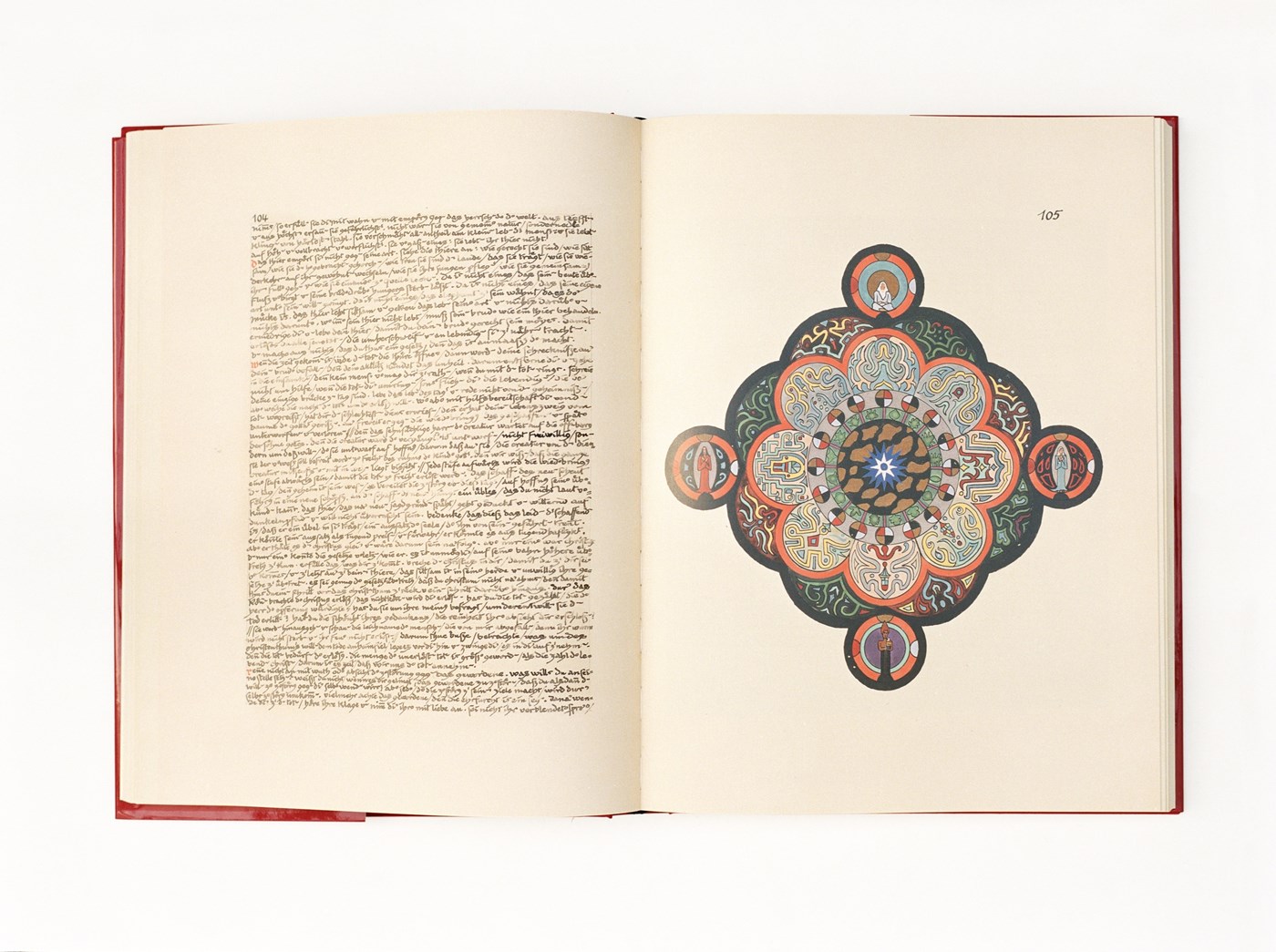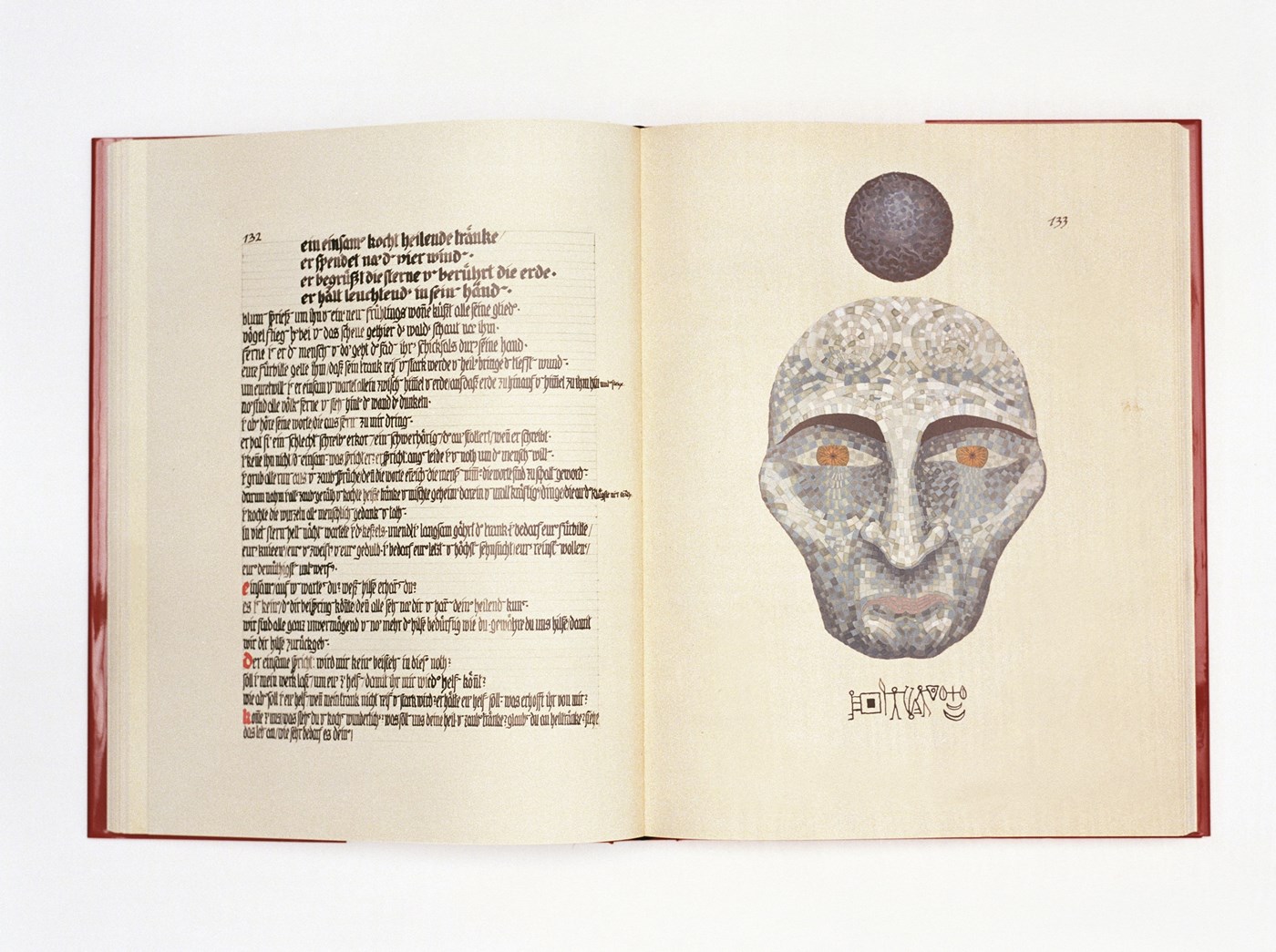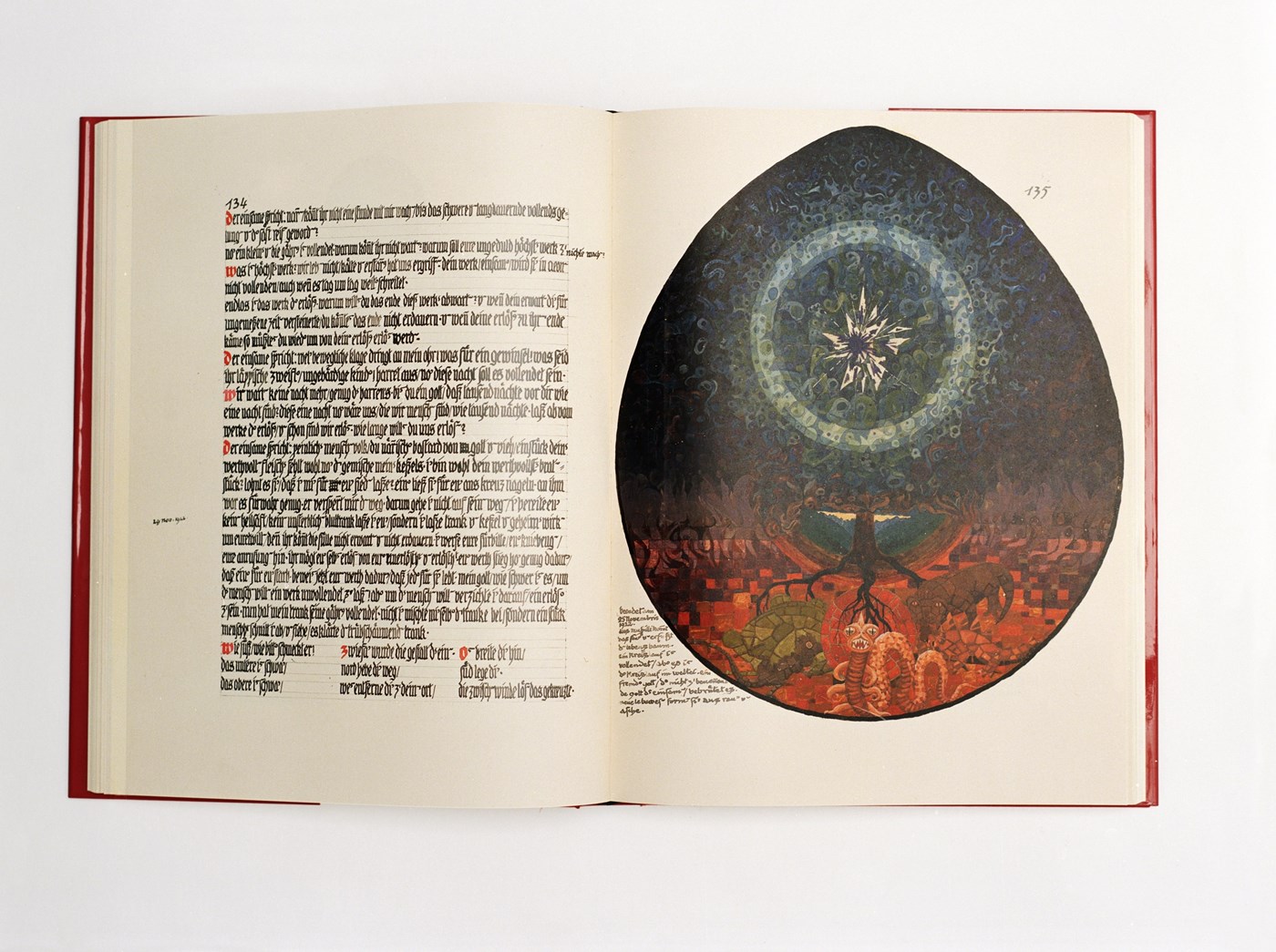Jung Man Blues
- TextJarvis Cocker
Jarvis Cocker invites you into the collective dreamworld of Carl Jung’s The Red Book
I remember taking some magic mushrooms in the very shabby kitchen of a shared house I was living in back in Sheffield in the mid-80s – I looked at the fridge & there were all these swirling paisley patterns on it & I thought, “Ah right – now I get it.” As in, now I get why loads of records & books & clothes from the psychedelic era have got paisley designs plastered all over them – because it’s what you see when you’re on hallucinogenic drugs. It’s like those patterns are lying dormant in the silt of your brain, waiting for something to disturb them so that they can float to the surface of your consciousness. But how did they get there in the first place? Did my fridge suddenly turn psychedelic because I’d watched some 60s films & knew that was what you were meant to see when you were ‘tripping‘ & so my mind projected them onto the nearest kitchen appliance? Or did they come from somewhere else? Somewhere deeper. Maybe from a vast reservoir of primordial images that all mankind has in common; images formed thousands of years ago, long before we had developed language? Carl Gustav Jung would argue in favour of the latter scenario.
I don’t think that I would have been aware of Jung back in my mushroom-taking days – or if I was, I would only have known of him as a one-time associate of Sigmund Freud – but what I was experiencing, in my small-time suburban way, was some kind of vindication of his theories of ‘oceanic consciousness’ & archetypal symbols: the idea that mankind has a library of shared imagery that transcends geographical & cultural divides & that only our subconscious has access to. I saw paisley patterns because psychoactive drugs made my subconscious available to me & made visible what was hiding down there. There are even theories that we see that particular pattern because we are actually observing the ‘wiring’ of our own brains – that our neural networks resemble these fractal-like designs. In other words, it’s a shared image because we are seeing our own minds, & the architecture of the human brain is the same the world over. & always has been.

The Red Book was finally published in 2009 – 48 years after Jung’s death. During the interim period it had become the subject of much speculation amongst his followers. What was in it? Why was it locked away with only his family allowed to view it? Why would someone work on something on & off throughout their whole adult life only to then keep it a secret? Of course, this kind of behaviour only inflames public curiosity (viz. J.D. Salinger) so the eventual publication of The Red Book caused something of a sensation. Was it justified?
The first thing that should be said about The Red Book is that it’s a difficult book to read. I’m not referring to the language it’s written in or the complexity of the ideas contained within it here (though they are factors) – I’m talking about how the book is 12.3” wide by 18” tall & weighs 3kg. It is physically difficult to read. I started trying to read it in bed at night & it nearly crushed me! My puny arms could not cope – never mind my puny intellect. Then consider these other facts: the introduction by leading Jungian scholar Sonu Shamdasani is 56 pages long alone, the book is an attempt at a modern version of the illuminated manuscripts that were produced in monasteries in the Middle Ages (very beautiful to look at but not easily legible for the reader), the language used is very austere, formal – quasi-biblical, if you wanted to take the book with you to read on holiday it would require its own suitcase. All these factors contributed to the failure of my first attempt at reading The Red Book. I gave up. I had to be content with leaving it on the bookshelf, looking impressive, & flicked through it from time to time looking at the illustrations. I could admire it but I couldn’t read it. It had beaten me.

All that changed in December 2012 – that was when a ‘Reader’s Edition’ of The Red Book became available. It would appear that I was not the only one who had found the original publication diffi cult to grapple with. A normal book size, 600 pages long, no pictures – now I could get to work. But while the physical difficulties associated with reading the book may have diminished, the intellectual ones remained: the book consists of descriptions of a series of visions that Jung had between 1903 & 1916 together with his interpretations of what he had seen. These visions were not drug-induced – Jung developed a method of ‘lucid dreaming’. He apparently taught himself to induce a dream-like state whilst retaining his ability to take notes on his subsequent inner adventures & revelations. The resulting descriptions are full of mythical figures – Philemon, Elijah, Salome – the language is formal & a little old-fashioned, the events described are often bizarre & highly symbolic. The overall effect is that of reading a ‘personal bible’ – & (my apologies, dear reader) I have never been able to read more than a few pages of the Bible before getting frustrated & a little bewildered, because I am reading something that is so central to so much of our culture & yet which feels very detached from the reality of modern life as I experience it. But I resolved to persevere with The Red Book. I can’t exactly say why (perhaps just the fact that I’d bought it twice & so felt I had to get my money’s worth?). I resigned myself to not understanding it all. I read a maximum of five pages per night before going to bed & then allowed what I’d read to percolate through my consciousness whilst I was asleep. Jung’s writings were all about the importance of the unconscious in our daily lives so why not let my unconscious mind try & make sense of The Red Book? Much of its subject matter is derived from dreams so why not let it haunt mine & see what happened? I made notes, underlined phrases that I liked, folded over the corners of pages that seemed somehow relevant. Sometimes I would re-read bits in the morning, & gradually, day by day I worked my way through it. I couldn’t say how long in total it took me to finish the book but it was certainly more than a year, & when I got to the end…. There was no blinding flash, I didn’t have a party to celebrate completion, I just had a mild sense of achievement – & a vague desire to read something a little ‘lighter’ next time.
But I hadn’t really finished The Red Book at all, because I’d only read it. & that meant that I’d only got half the story. The Red Book may be a difficult book to read but it is a beautiful book to look at. & for once you don’t have to feel guilty about skimming over the text & just looking at the pictures: the pictures are the raw material, the visions rendered visible – the text is merely an attempt at an explanation. In a way the text is there to illustrate the pictures rather than vice versa. The unconscious communicates in images (I didn’t see words on that grubby fridge years ago, I saw patterns.)

I perhaps wouldn’t have realised the primary significance of the paintings if I hadn’t visited the Venice Biennale in 2013. There, in the exhibition Il Palazzo Enciclopedico curated by Massimiliano Gioni, The Red Book had pride of place: it was the first thing you saw when walking into the Pavilion. The message was clear: “This is the way in, this is the key to understanding the rest of the work in this exhibition.” Work by Outsider Artists & Visionary Artists alongside more familiar artworld names. There, displayed as art rather than pages from a book, the pictures first really hit me. Jung himself struggled with what to call his paintings – he absolutely refused to call them ‘art’ – & he hid The Red Book away because he worried that people would not take his subsequent books seriously if they saw that they all originated from a set of fevered ‘psychedelic’ visions.
Indeed, many people comment that the pictures remind them of ‘head’ paintings from the late 1960s – but you must remind yourself that they were made more than 50 years before the hippie movement was born. & Jung was most definitely not ‘high’ when he made them. Many are mandalas: circular, spiritual symbols normally associated with Hinduism & Buddhism. At fi rst Jung didn’t know why he was painting them & then it struck him: “…the mandala is the centre… It is the path to the centre, to individuation. One cannot go beyond the centre.” For Jung this was a major revelation & defi ned the direction of the rest of his life’s work. As he put it in the book Memories, Dreams, Reflections (published posthumously in 1963): “The years when I was pursuing my inner images were the most important in my life – in them everything essential was decided… the later details are only supplements & clarifications of the material that burst forth from the unconscious, & at first it swamped me.” I believe that is the reason Signor Gioni put them at the very centre of the Venice exhibition: at a time when we are being bombarded by external images at a rate unprecedented in human history, it is very important to be reminded that the really vital images – the ones that can really make a difference to us, are already there. They are inside us from day one – every one of us. We just have to learn how to access them – to turn our gaze inwards – & then try to understand them.

There is such a lot written nowadays about how we are living in a ‘connected’ society – Jung’s message is that we always have been. When we fall asleep at night we all swim in the same ocean: an ocean populated by primordial images that have been there since the dawn of humanity. It’s the original ‘dark web’. Isn’t that a great idea? Isn’t it exciting to realise that there’s a whole universe inside every one of us that is just as vast as the one outside us? & that we can explore it anytime we want? (No mushrooms required.) A common human resource open to all. (No wi-fi connection required.) It’s what Jung called “the pool of life” – indeed, one of his most famous mandalas depicts the ‘LiverPool’, or ‘Liverpool’ if you like, based on a vision he had of a city he never visited & yet knew to be hugely significant. & did you know…
But you know what? That story can wait for another time. In the meantime, fancy going for a dip tonight? Who knows what adventures we might bump into out there on the high seas? (Or rather ‘in’ there on the high seas.) It’s all there for us to discover: sea monsters, holy mountains, paisley fridges… When you open The Red Book you are opening a portal to a whole new world. The world inside yourself. The world you share with every other human being on earth.
Welcome.












